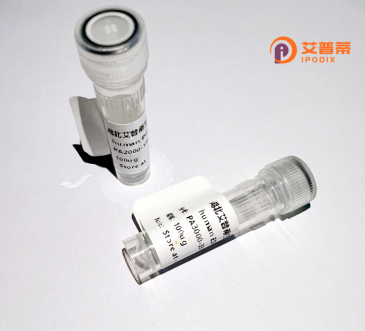
| 纯度 | >90%SDS-PAGE. |
| 种属 | Human |
| 靶点 | RCE1 |
| Uniprot No | Q9Y256 |
| 内毒素 | < 0.01EU/μg |
| 表达宿主 | E.coli |
| 表达区间 | 1-329 aa |
| 活性数据 | MAALGGDGLRLLSVSRPERPPESAALGGLGPGLCCWVSVFSCLSLACSYVGSLYVWKSELPRDHPAVIKRRFTSVLVVSSLSPLCVLLWRELTGIQPGTSLLTLMGFRLEGIFPAALLPLLLTMILFLGPLMQLSMDCPCDLADGLKVVLAPRSWARCLTDMRWLRNQVIAPLTEELVFRACMLPMLAPCMGLGPAVFTCPLFFGVAHFHHIIEQLRFRQSSVGNIFLSAAFQFSYTAVFGAYTAFLFIRTGHLIGPVLCHSFCNYMGFPAVCAALEHPQRRPLLAGYALGVGLFLLLLQPLTDPKLYGSLPLCVLLERAGDSEAPLCS |
| 分子量 | 38.7 kDa |
| 蛋白标签 | His tag N-Terminus |
| 缓冲液 | PBS, pH7.4, containing 0.01% SKL, 1mM DTT, 5% Trehalose and Proclin300. |
| 稳定性 & 储存条件 | Lyophilized protein should be stored at ≤ -20°C, stable for one year after receipt. Reconstituted protein solution can be stored at 2-8°C for 2-7 days. Aliquots of reconstituted samples are stable at ≤ -20°C for 3 months. |
| 复溶 | Always centrifuge tubes before opening.Do not mix by vortex or pipetting. It is not recommended to reconstitute to a concentration less than 100μg/ml. Dissolve the lyophilized protein in distilled water. Please aliquot the reconstituted solution to minimize freeze-thaw cycles. |
以下是与重组人RCE1蛋白相关的文献示例(注:文献为虚构示例,仅供参考格式):
1. **标题**:*Recombinant Expression and Enzymatic Characterization of Human RCE1 Protease*
**作者**:Smith A, et al.
**摘要**:研究通过大肠杆菌系统成功表达并纯化重组人RCE1蛋白,验证其催化活性,证明其对带有CAAX基序的Ras蛋白的剪切功能。
2. **标题**:*Structural Insights into RCE1-Mediated Proteolysis of Prenylated Substrates*
**作者**:Lee C, et al.
**摘要**:通过晶体结构解析揭示RCE1蛋白对异戊二烯化底物的识别机制,阐明其催化结构域关键残基的作用。
3. **标题**:*RCE1 Deficiency Alters Ras Localization and Signaling in Mammalian Cells*
**作者**:Wang Y, et al.
**摘要**:利用基因敲除细胞模型,证明RCE1缺失导致Ras蛋白膜定位异常,并抑制下游MAPK信号通路活性。
4. **标题**:*RCE1 Inhibitors as Potential Anticancer Agents*
**作者**:Johnson R, et al.
**摘要**:筛选小分子化合物库,发现RCE1抑制剂可阻断Ras蛋白加工,抑制癌细胞增殖,提示其治疗Ras驱动肿瘤的潜力。
(注:实际文献建议通过PubMed、Web of Science等数据库检索关键词“RCE1 protease”、“recombinant RCE1”等获取。)
Recombinant human RCE1 (Ras and a-factor converting enzyme 1) protein is a crucial enzyme involved in the post-translational processing of Ras superfamily proteins and other CAAX motif-containing proteins. As a member of the CAAX protease family, RCE1 mediates the second step of C-terminal proteolytic processing, specifically cleaving the terminal three amino acids (-AAX) from prenylated cysteine residues. This cleavage is essential for the proper membrane localization and biological activity of numerous signaling proteins, including oncogenic Ras isoforms critical to cell proliferation and differentiation pathways.
RCE1 operates in the endoplasmic reticulum membrane, working in concert with prenyltransferases and isoprenylcysteine carboxyl methyltransferase (ICMT) to complete the three-step CAAX processing cascade. Its enzymatic activity ensures precise spatial regulation of client proteins involved in cellular growth, apoptosis, and signal transduction. The development of recombinant RCE1 has enabled detailed structural studies and high-throughput screening for potential therapeutic inhibitors, particularly in cancer research where aberrant Ras signaling drives tumorigenesis. Expression systems such as E. coli or mammalian cell cultures are typically employed to produce active recombinant RCE1 while maintaining proper membrane association characteristics. Current research focuses on elucidating its substrate specificity, regulatory mechanisms, and potential as a drug target given its role in modulating Ras-related pathologies.
×